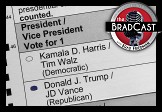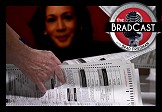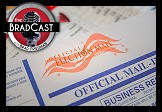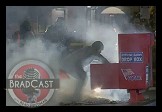Guest Blogged by John Gideon, VotersUnite
 As set up by the Help America Vote Act of 2002, the U.S. Election Assistance Commission (EAC) receives some advice from a Board of Advisors. The Board is made up of a set number of people representing groups like the National Association of Secretaries of State; National Governors Association; International Association of Clerks, Recorders, Election Officials and Treasurers; congressional leaders; and even two members of The Election Center, a vendor-sponsored group that promotes electronic voting. There are no voters groups and no one from the election integrity community on the Board. But then, who cares what the voters think?
As set up by the Help America Vote Act of 2002, the U.S. Election Assistance Commission (EAC) receives some advice from a Board of Advisors. The Board is made up of a set number of people representing groups like the National Association of Secretaries of State; National Governors Association; International Association of Clerks, Recorders, Election Officials and Treasurers; congressional leaders; and even two members of The Election Center, a vendor-sponsored group that promotes electronic voting. There are no voters groups and no one from the election integrity community on the Board. But then, who cares what the voters think?
The Board of Advisors is advising [PDF, pg 7] the EAC, via resolution, that they need to speed-up the certification process for voting systems. They want the system to be what it was under the old, rubber-stamp system headed by the National Association of State Elections Directors (NASED). They want the same system of testing and certification that has resulted in our voting systems failing in many elections and not even being compliant with federal standards.
Incredibly, the Board's recommendation to the EAC goes so far as to admit that a failed "common practice" of the past should, apparently, be re-instituted under the newer certification system. "The common practice since the introduction of electronic voting systems," they wrote, "has been to make hardware and software upgrades based on issues found in the most recent election in sufficient time to improve the voting systems for the next general election."
That is a stunning admission. That that is a system they'd like to return to is even more stunning.
The EAC is holding a public meeting in Phoenix later this month and the Board of Advisors' resolution is to be discussed by the commissioners. I sent the following email to the commissioners and staff of the EAC to voice my concerns about the resolution.
My letter to them follows in full below...
The EAC Board of Advisors Resolution 2008-3 is a shocking recommendation against the EAC's decision to carry out the voting system certification process responsibly. One has to wonder whether the Board's recommendation is in the best interest of the EAC and the people of the United States or the best interest of the voting machine industry.
The Board mentions that previous to the EAC taking control of voting system certification, a volunteer process was operated by the National Association of State Election Directors (NASED). This “volunteer process” was actually run with the same lack of care as a “volunteer process” is often run. While they did “qualify” voting systems and oversaw a flawed, vendor-controlled, Independent Test Authority process; the process was conducted in such a way as to result in error-prone voting systems being on the market with NASED’s approval. No “qualified” voting systems were tested to ensure compliance with HAVA Section 301(a)(3). Voting systems that were qualified by NASED regularly violate HAVA Section 301(a)(5), which means that testing to the Voting System Standards either was not accomplished at all or was not properly done.
As an example of how flawed the NASED process was, one of its ITAs, Ciber, was denied interim accreditation, and only now, after over a year, the lab is being reconsidered for accreditation. While the denial of accreditation was for not notifying the EAC that key employees had left the company, the EAC, in a February 1, 2007 letter to the company, reported non-compliance to appropriate ISO/IEC standards and the NIST Handbooks. The company that had been entrusted with testing a majority of the software of NASED qualified voting systems had kept such poor records that it was impossible to determine how much testing had actually been accomplished or what the results had been. These were voting systems that were qualified under the “volunteer process” established by NASED.
The Board then goes on to mention that the EAC would not accept the testing performed by NASED. The Board incorrectly uses the term “certification testing”. In fact no “certification testing” was ever accomplished by NASED or the ITAs. NASED merely attested that the equipment had been tested and that it "qualified" as meeting the federal standards.
Based on the history of voting machine failures over the past four years, on NASED-qualified voting systems, no wonder the EAC refused to accept the testing performed by NASED. The system was a failure and the voting systems it qualified are failures.
The Board then goes on to make a statement that gives credence to information the Election Integrity community has known for years and that the vendors and their supporters have denied. The Board says: “the common practice since the introduction of electronic voting systems has been to make hardware and software upgrades based on issues found in the most recent election in sufficient time to improve the voting systems for the next general election”. This is a stunning admission.
It has been clear to the EI community that voting systems were being “beta tested” in real elections. The Board has now acknowledged the truth of it. Rather than provide a product that was properly designed, manufactured, and tested, the voting machine industry has manufactured and sold inadequately tested products, and real elections, with real voters voting for real candidates, have been used to test those products so improvements could be made in the next election.
Douglas Kellner, co-chair of the New York State Board of Elections, was just quoted on this very subject in Wired Magazine’s “Threat Level” blog:
"There's no way the vendor could be adequately reviewing the machines and having so many problems," he told Threat Level. "What it tells us is that the vendor just throws this stuff over the transom and does not do any alpha- or beta-testing of their own before they apply for certification testing. Then they expect that we'll identify technical glitches and then they'll correct those glitches. But correction of those glitches is an extraordinarily time-consuming process. And its very disappointing that this equipment is not ready for prime time."
The Board then posits that the current EAC process, if not made quicker, will cause states to consider moving away from the federal certification process. Many states already do NOT require that voting systems be federally certified though many of those do require compliance to the voting system guidelines. Though the Board warns that the states will have varying standards; that is already the case.
The Board then resolves that the certification process must be sped up so states can use updated systems this year. They do not appear to be aware of the fact that, at this late date, most jurisdictions would correctly be reluctant to deploy new systems for 2008. They do not appear to be concerned with the fact that the process is slow because voting systems are failing the EAC's testing. They do not appear to care whether or not voting systems comply with HAVA Section 301. By recommending that roadblocks and barriers be removed from the process, the Board is actually recommending that EAC continue the flawed NASED process of years past and allow voting systems to be Beta Tested in November so the vendors can fix the problems before elections the next year.
The EAC must reject this resolution and continue the process of testing voting systems that, we hope, will not need to be “beta tested” in November.


 How (and Why!) to 'Extend an Olive Branch' to MAGA Family Members Over the Holidays: 'BradCast' 11/21/24
How (and Why!) to 'Extend an Olive Branch' to MAGA Family Members Over the Holidays: 'BradCast' 11/21/24 'Green News Report' 11/21/24
'Green News Report' 11/21/24
 Former Federal Prosecutor: Trump Must Be Sentenced in NY Before Taking Office Again: 'BradCast' 11/20/24
Former Federal Prosecutor: Trump Must Be Sentenced in NY Before Taking Office Again: 'BradCast' 11/20/24 'Bullet Ballot' Claims, Other Arguments for Hand-Counting 2024 Battleground Votes: 'BradCast' 11/19/24
'Bullet Ballot' Claims, Other Arguments for Hand-Counting 2024 Battleground Votes: 'BradCast' 11/19/24 'Green News Report' 11/19/24
'Green News Report' 11/19/24 Trump Already Violating Law (He Signed!) During Transition: 'BradCast' 11/18/24
Trump Already Violating Law (He Signed!) During Transition: 'BradCast' 11/18/24 Sunday 'Into the Gaetz of Hell' Toons
Sunday 'Into the Gaetz of Hell' Toons Computer Security Experts Ask Harris to Seek Hand-Counts Due to Voting System Breaches: 'BradCast' 11/14/24
Computer Security Experts Ask Harris to Seek Hand-Counts Due to Voting System Breaches: 'BradCast' 11/14/24  'Green News Report' 11/14/24
'Green News Report' 11/14/24 Trump Criminal Cases Fade After Election as GOP 'Does Not Believe in Rule of Law': 'BradCast' 11/13/24
Trump Criminal Cases Fade After Election as GOP 'Does Not Believe in Rule of Law': 'BradCast' 11/13/24 Climate Advocates Brace for Fight With Trump 2.0: 'BradCast' 11/12/24
Climate Advocates Brace for Fight With Trump 2.0: 'BradCast' 11/12/24 'Green News Report' 11/12/24
'Green News Report' 11/12/24 Let It All Out: 'BradCast' 11/11/24
Let It All Out: 'BradCast' 11/11/24 Sunday 'Like it or Not' Toons
Sunday 'Like it or Not' Toons Not All Bad: Abortion Rights Won Big (Almost) Everywhere: 'BradCast' 11/7/24
Not All Bad: Abortion Rights Won Big (Almost) Everywhere: 'BradCast' 11/7/24 'Green News Report' 11/7/24
'Green News Report' 11/7/24 U.S. CHOOSES CONVICTED CRIMINAL, ADJUDICATED RAPIST: 'BradCast' 11/6/24
U.S. CHOOSES CONVICTED CRIMINAL, ADJUDICATED RAPIST: 'BradCast' 11/6/24 ELECTION DAY 2024: Tea Leaves, Probs for Voters, What's Next: 'BradCast' 11/5/24
ELECTION DAY 2024: Tea Leaves, Probs for Voters, What's Next: 'BradCast' 11/5/24 'Closing Arguments' for Undecideds, Third-Party Voters: 'BradCast' 11/4/24
'Closing Arguments' for Undecideds, Third-Party Voters: 'BradCast' 11/4/24 The GOP 'Voter Fraud' Before the Storm: 'BradCast' 10/31/24
The GOP 'Voter Fraud' Before the Storm: 'BradCast' 10/31/24 'Closing Arguments'with Digby and Driftglass: 'BradCast' 10/30/24
'Closing Arguments'with Digby and Driftglass: 'BradCast' 10/30/24 Trump Promises to be a Lawless, Authoritarian President. Believe Him: 'BradCast' 10/29/24
Trump Promises to be a Lawless, Authoritarian President. Believe Him: 'BradCast' 10/29/24 Ballots Burn, Billion-aires 'Obey in Advance', Callers Ring In: 'BradCast' 10/28/24
Ballots Burn, Billion-aires 'Obey in Advance', Callers Ring In: 'BradCast' 10/28/24 Musk's Privatized Internet Satellite System Threatens U.S. National Security
Musk's Privatized Internet Satellite System Threatens U.S. National Security
 VA GOP VOTER REG FRAUDSTER OFF HOOK
VA GOP VOTER REG FRAUDSTER OFF HOOK Criminal GOP Voter Registration Fraud Probe Expanding in VA
Criminal GOP Voter Registration Fraud Probe Expanding in VA DOJ PROBE SOUGHT AFTER VA ARREST
DOJ PROBE SOUGHT AFTER VA ARREST Arrest in VA: GOP Voter Reg Scandal Widens
Arrest in VA: GOP Voter Reg Scandal Widens ALL TOGETHER: ROVE, SPROUL, KOCHS, RNC
ALL TOGETHER: ROVE, SPROUL, KOCHS, RNC LATimes: RNC's 'Fired' Sproul Working for Repubs in 'as Many as 30 States'
LATimes: RNC's 'Fired' Sproul Working for Repubs in 'as Many as 30 States' 'Fired' Sproul Group 'Cloned', Still Working for Republicans in At Least 10 States
'Fired' Sproul Group 'Cloned', Still Working for Republicans in At Least 10 States FINALLY: FOX ON GOP REG FRAUD SCANDAL
FINALLY: FOX ON GOP REG FRAUD SCANDAL COLORADO FOLLOWS FLORIDA WITH GOP CRIMINAL INVESTIGATION
COLORADO FOLLOWS FLORIDA WITH GOP CRIMINAL INVESTIGATION CRIMINAL PROBE LAUNCHED INTO GOP VOTER REGISTRATION FRAUD SCANDAL IN FL
CRIMINAL PROBE LAUNCHED INTO GOP VOTER REGISTRATION FRAUD SCANDAL IN FL Brad Breaks PA Photo ID & GOP Registration Fraud Scandal News on Hartmann TV
Brad Breaks PA Photo ID & GOP Registration Fraud Scandal News on Hartmann TV  CAUGHT ON TAPE: COORDINATED NATIONWIDE GOP VOTER REG SCAM
CAUGHT ON TAPE: COORDINATED NATIONWIDE GOP VOTER REG SCAM CRIMINAL ELECTION FRAUD COMPLAINT FILED AGAINST GOP 'FRAUD' FIRM
CRIMINAL ELECTION FRAUD COMPLAINT FILED AGAINST GOP 'FRAUD' FIRM RICK SCOTT GETS ROLLED IN GOP REGISTRATION FRAUD SCANDAL
RICK SCOTT GETS ROLLED IN GOP REGISTRATION FRAUD SCANDAL VIDEO: Brad Breaks GOP Reg Fraud Scandal on Hartmann TV
VIDEO: Brad Breaks GOP Reg Fraud Scandal on Hartmann TV RNC FIRES NATIONAL VOTER REGISTRATION FIRM FOR FRAUD
RNC FIRES NATIONAL VOTER REGISTRATION FIRM FOR FRAUD EXCLUSIVE: Intvw w/ FL Official Who First Discovered GOP Reg Fraud
EXCLUSIVE: Intvw w/ FL Official Who First Discovered GOP Reg Fraud GOP REGISTRATION FRAUD FOUND IN FL
GOP REGISTRATION FRAUD FOUND IN FL


































